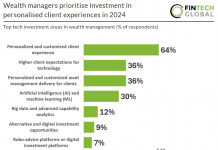A lot of the current robo advisor offerings don’t actually give advice and instead provide consumers with guidance, according to Santander UK head of compliance Joel Viney in a research interview with FinTech Global.
Santander launched its Digital Investment Adviser service last month, in a bid of filling a gap it has seen in the market of providing consumers with a genuine advisor solution. The current issue that Viney sees is that a lot of the current propositions are giving users more guidance than advice, which is fine for some people, but a lot of those in the market need more support. This is where Santander’s new solution is looking to change the space by offering a full personal recommendation and suitability report.
Viney said, “We recognised given the advice gap and changes RDR implemented did mean that access was restricted for lots of customers who could benefit especially given the current economic environment with interest rates so low.”
The real aim of the adviser is to provide the consumers with the education and insights, so they are able to take the information away and build their own knowledge of investing, instead of just telling them to invest here, or there.
Joel Viney said, “It gives a personal recommendation and full suitability assessment; whereas, most robo-advisors don’t actually do that, they offer some forms of guidance rather than an actual personal recommendation. We decided early on we wanted to stand behind a full personal recommendation and issue a suitability report and give the customer advice, rather than to guide them, in order to make their own decisions.” It’s about helping them to see what their finances are really doing, and how savings may not be earning them as much as they could be.
The bank has joined the group of traditional financial institutions to provide its customers with investment support. Wells Fargo launched its robo-advisor solution in 2017 and Bank CIC released its solution earlier this year. However, its not all been easy pickings for financial institutions, with UBS shutting down its SmartWealth solution down and selling it to SigFig, a personal finance FinTech.
He added, “I think all of the different versions of robo-advisors do have a place in the market because, especially in the economy we have, investing is the right option for a lot of people.” Although, not everyone is investing with the same level of experience, and Viney actually thinks the segment is ‘almost upside down’, as those that have the access to advice or the disposable money to invest, often already have experience in the market and do not need help. Santander decided it wanted to make investing and advice available to everyone, and cater to those that are new or tried to invest but were overwhelmed at the start by jargon and different offerings.
“I think customers possibly need that extra level of support, which is why none of the robo advisors that currently exist have made a significant impact on the advice gap. It’s individuals usually that do use investments and that have experience, that will likely use robo advisors, whereas what we want to try and do is address the balance of those that are underserved and don’t have access yet.”
The platform offers a low entry level with consumers are able to get started with a lump sum of £500 or £20 a month, enabling better inclusion rates. One thing Santander has spent a lot of time doing was to ensure the platform avoided jargon and was easy to understand. While professionals might use phrases daily and think they are obvious, a new entrant in the space may not feel the same way.
Viney said, “That’s one of the big things we see as to why people don’t engage with investments or financial services more broadly, because they don’t feel motivated to do it. Then, a lot of the time when they try, they don’t understand it because of the language or its emotionally draining.”
Santander is aiming to keep customer engagement as high as possible especially at the beginning of the journey. The challenge is to not leave consumer disheartened to join due to a long introduction. Having a long intro can remove the motivation of a consumer to start, especially when they are already hesitant to interact with their finances. Starting off the customer interaction from a low point, is never going to end well and is likely to see a lot of customers give up before they’ve even started and made investments.
What really helps to set the Digital Investment Adviser apart from other solutions is its approach to risk assessment. Instead of just basing this on a standard psychometric, 5-point likert scale tests and human questionnaires, the platform implements a BIQ tool which balances aptitude for risk with aversion to loss. By doing this, Santander is hoping to build better understandings of how customers will react in different scenarios, which current face-to-face risk assessments can’t really achieve.
This tool implements behavioural elements which create scenarios to test how customers reach in situations and this is layered on top of the traditional risk assessment tests. Traditional propositions do not incorporate and attitudes towards loss, but this can have a major impact on how a customer is willing to invest, especially if they start to see losses.
In order to balance these two aspects, the platform incorporates a present bias to see where the investors are looking towards and how this could impact their risk/loss views. Viney said, “For example, if you have someone with a high attitude to risk but high aversion to loss and the present bias indicates that they are very focused on the present, then you wouldn’t want to expose them potentially to an investment which would fluctuate greatly and perhaps their behaviour might mean they would pull out an investment at an inappropriate time when markets are low.”
FCA and utilising their support
Santander worked very closely with the UK’s Financial Conduct Authority (FCA) when designing and bringing its Digital Investment Adviser to life. The bank made use of a lot of the reports they have published around the robo-advisory space, and were also a part of their advice unit. This enabled them to seek help from the FCA whenever they needed it.
Viney said, “The FCA are doing a lot, the initiatives they have in within their project innovate, so the sandbox and advice unit, are excellent tools and firms should definitely engage with them if those if they are considering something like this.”
By having more interactions between the two, not only with robo-advisor firms be able to build better solutions, but the regulator will also benefit from improved services. If the FCA is having more interactions, they can start to see what firms are trying to achieve and the challenges they are facing. In turn, this boosts their capabilities in addressing any issues or challenges facing them.
“The FCA’s ability to do that within their initiatives only gets better with the more firms that engage with it because they build up their knowledge and understanding of what firms are trying to achieve and in turn they can try and respond to help.”
There is a desire from the FCA to support innovation, not just on the side of investing, but in relation to general awareness to finances and management by consumers, Viney stated.
Going into the future, there needs to be more of a balance between the platforms giving advice and those offering guidance. At the moment, a lot of the advisor platforms available are not actually advisors, under the regulatory description of advisory as they don’t offer personalised recommendations or suitability reports. Having a more balanced market is something Viney feels the regulators will echo.
A report was recently published by the FCA outlining a customer facing definition of advice versus guidance in order to help customers understand the difference. While this has been helpful to the market, the job is not solely on them, and firms should be doing more in explaining and making things more transparent. There is a need for more educational material to help the consumers and make sure they’re not intimidated by the investing world.
Going forward in the future, Viney believes that while the market has been heavily skewed towards guidance it will begin to balance. Some smaller firms could struggle to find customers, but this is a segment that truly needs to work. “You might see some either amalgamate or pair or team up with larger institutions and if that happens it will be a successful segment. Customers need this and a lot of customers probably recognise now that they need this more so than before because of the economic environment, so if the right solutions are there customers will engage with it and it will be successful.”
Copyright © 2018 FinTech Global











